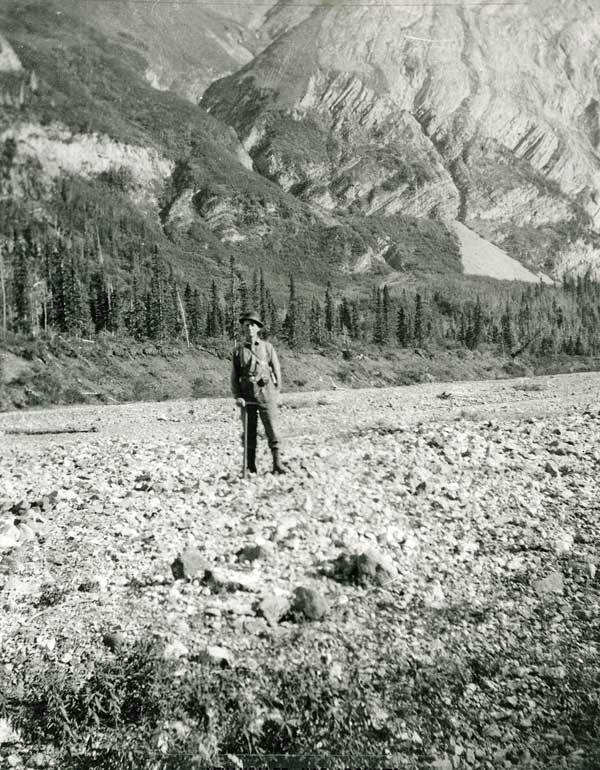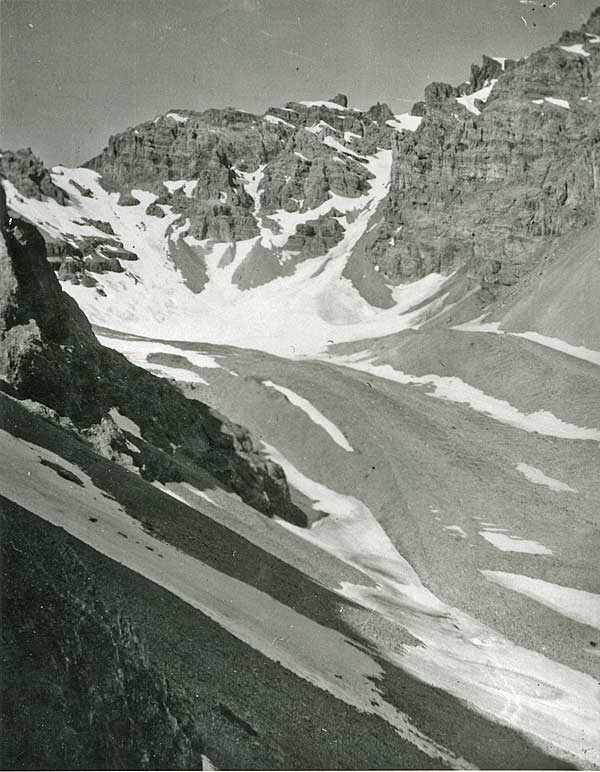
Kennecott
at night in the mid-1920s --Anchorage Museum of
History & Art
|
|
Frank Buckner sat at his small desk in his second floor room in the
white-painted staff house at Kennecott. Winter brought heavy snows early as
late November approached. He was writing to a college classmate from the days of his schooling at the Colorado School of Mines. Frank had no immediate
relatives and few friends from his years before coming to Kennecott in 1923.
Thanksgiving was approaching, and Frank was feeling a need to write. Collin
had expressed an interest in Alaska mining, and Frank had corresponded with him before. There really was not much else to discuss but mining and geology.
There were the diversions at Kennecott--the occasional silent film, the library book exchange, the ice-rink, hiking, hunting and other outdoor activities. But Kennecott was not the States. It was isolated and social opportunities were limited. Only about thirty people--engineers, foremen and others in upper management--had families there. On the other hand, the work schedule largely precluded anything else but work. The company had Thanksgiving dinners for the employees at the mine sites, for those at the mill site, and a number of private dinners. Frank and the other bachelor engineers were always invited to dinner at the superintendent’s large home.
Kennecott staff house in 1924 |
Most of the time, the relative isolation of living at camp, even among suited Frank fine. But there is something about Thanksgiving which made Frank want to write to someone outside of camp. Since he was about to move out of the main camp to take a new assignment at Mother Lode, he decided to write on the subject.
From his single window, he could see uphill toward Superintendent Bill Douglass’s residence. It was a low-lying, rambling, white-painted structure which had seen a number of additions over the last few years as the Douglass family grew. Now it had grown to four bedrooms, making it almost as large as the more elaborate, two-story Stephen Birch house, which was farther up the sidewalk and now stood dark and empty. Kennecott had a manager assigned there who would ordinarily occupy the elaborate place--the only house in town with a fireplace. That fireplace had brilliantly-colored covellite, azurite and malachite ore instead of bricks. It had been built for the Great Man, himself back in 1916, but had never been used by him except on rare annual overnight visits.
Stephen Birch stayed there for the last time three yeas ago. That was when the managers decided to downgrade the Alaska mine in relationship to the corporation. The Birch house now stood silhouetted against the darkness, accentuated by its stark white color, giving a stern and dominating appearance from its relatively lofty perch overlooking all else, much like the Great Man himself.
The hospital was directly below the Birch House. It was the only other building in the mill town besides the staff house, and the Douglass and the Birch houses which was painted white with dark-green trim The hospital was relatively large and was always lighted.
Across National Creek were two barracks. The tallest one was used primarily by the mill workerswhile the other--the original National Creek barrack--seldom housed anyone anymore. It housed the private mess for the engineers and teachers, a small library, a bottling room for the dairy and a room used by the visiting dentist. No one was there and the lights were off, just as at the Birch House.
Frank turned to his writing.
Where to begin?
Frank had a strong grasp of the relatively brief but also somewhat complex history of Kennecott. He had made of point of asking many questions about the workings and history of the place. He had become an expert on the subject.
|
Frank Buckie (real name), junior engineer, 1924
|
Since I am taking the new assignment to Mother Lode, that’s the subject...
Now, the time, the time, the time....
Kennecott took control of ML in 1918, so that seems like a good place to start...
Let’s see.
Dear Collin,
Thank you for your last letter. I was especially interested in the updates at the Butte since you started working there some years after I left. What a happy coincidence. It was a very interesting place, and one which prepared me well
for my present assignment. That an old classmate of mine would end up there in my old territory is indeed pleasing.
There is, as you undoubtedly realize, quite a contrast between our two mines. This interior Alaska mine is very small compared to Butte, but the grade of copper makes up for it by being so high that only a tenth of the manpower is needed to produce a third of the results. If this were not a high-grade mine, it would never have been developed way out here in such remote, mountainous and otherwise impossible country. But this one is high-grade almost beyond belief. Since I wrote you last, I have received a new assignment. Although I am still the junior engineer here, I have been elevated to the job of project engineer at Kennecott’s Mother Lode mine, which is situated above McCarthy Creek. Of course, I am also to be the only engineer there, but that’s beside the point.
In truth, for a number of reasons, no one else really wanted the assignment. Maybe the others all really wanted me to have it as a way to help me further my career. I would certainly like to think so. In any case, I am thrilled to have this new job and
title. So let me test your patience and write a little of the background of Mother Lode.
The Mother Lode
claims were held by another company until 1918 when Kennecott purchased fifty-one percent of them, committing badly needed development money for the eighty-six claims which cover over 1500 acres. This compares to the other Kennecott claims, of which there are 171 which cover over 5200 acres. However, that includes four large mine sites as well as the mill and all the area required for aerial tramming.
It all started with the purchase that year.

ABOVE: Kennecott consultant geologist Lewis Levansaler
at McCarthy Creek investigating the Mother Lode properties.
|
BELOW: Mother Lode / Potter Gulch, future site
of the upper Mother Lode camp and mine site. both from
Lewis Levansaler Collection, UAF Photo Archives |

|
He paused when a sudden strong gust hit the building, rattling his window. It was getting too dark to see much outside, but he could see snow being blown around, drifting over the long, straight, wooden walkway. The lights blinked, but the power held. He reached over to feel a hot radiator. On the floor a small rug helped keep his bare feet warm and comfortable. He leaned back on his chair, nearly flipping it over. He barely recovered his balance, then allowed the chair to return solidly fully to the floor. Frank felt embarrassed, even though no one
was there to see him, for being so clumsy. He resumed.
1918 began with a series of winter storms resulting in unusually heavy snow accumulations along Bonanza Ridge. The Bonanza Mine upper camp is located at approximately the 6000
foot level, about 1000 feet below the top of Bonanza Peak. The peak is the high point of the ridge and marks the divide of the north-south running ridge which merges to the south into Porphyry Mountain -- a large basalt formation.
This terrain is subject to heavy erosion and consists mainly of exceedingly steep rock faces and large talus slides. The upper thousand feet tends to build up a considerable snow load before forces ntural or man-made trigger avalanches. All of the upper camps--Bonanza, Jumbo, Mother Lode and Erie -- are located in areas which could be considered slide zones, but the Mother Lode is located in a particularly hazardous area along the steep eastern side of a ridge which separates the Kennicott Glacier valley from McCarthy Creek. This creek originates at an ice fall in the north, then heads directly south between two steep ridges which form canyon walls, before turning west where it flows through
the small settlement of McCarthy on its way to the Kennicott River.
The slide zone, originally named Potter Gulch, after Ocha Potter who was sent there early on to begin developing the property, is now more commonly known as Mother Lode Gulch.
It is composed almost entirely of scree from a point high above the upper camp. The loose rock is a steep slide all the way to the creek about a mile below in tram distance. The original Mother Lode company built a base camp just downstream from Diamond Creek--the upper boundary of the mill claims. The lower
camp included a stable, bunk house, managers house and a warehouse and shop. A gravity tram was extended from the creek to the original upper camp at the 5200 foot level. Kennecott later added a thirty-five horse motor to give the tram power for hauling materials from the creek. Limited mining operations began in
1913. The camp was built on a pile of waste-ore from the Marvelous vein prospect tunnel, which was cut in to the cliff-face about 200 feet above the camp.

Engineers' Staff House in winter --McCarthy-Kennicott
Hst Soc.
|
Once again a gust of wind caused the window to shudder. Frank stood up and pressed his face against the window to see out. The steep hill leading up to the Douglass house was bright-white with snow. It was too dark to see if it was drifting out there. The lights shined brightly out of the living room window. Douglass was home tonight, as was usually the case.
It must be
nice to have a wife and family and live so comfortably. He’ll never be alone up there. Not with four kids and a wife. I wonder if those children know how lucky they are to grow up here in this wonderful place.
Frank got up to
remove his heavy outer wear and place them in the closet with his boots. He put on his heavy, long, comfortable robe and sat back down to continue writing. Someone knocked on the door. He turned around, ready to yell “come in,” then realized he had to get up to open the door, as it was already locked. It was Ellen.
“Ellen, what are you doing on the mens’ floor?”
The pretty, red-haired girl was embarrassed to catch Frank in just his robe, but she was beginning to think of him often and was just happy to see him. Her initial look of embarrassment turned to one of school-girl excitement.
“Frankie, I brought some hot tea back from the hospital. I thought you’d like me to leave you the kettle and a cup.”
“Ellen! You’re
wonderful! That’s so kind and thoughtful.”
Frank took the cup and hot kettle and set them down on a towel on his bureau. He turned back, grabbed the young nurse, and hugged her, practically pulling her feet off the floor.
“I was just thinking how nice it would be to have some hot tea up here! You must have read my mind.”
“I think of you often, Frankie.”
“Will I be seeing you for early breakfast tomorrow, Ellen? I’m usually there at six-thirty. I’d love you to join me. It’s so solitary around here.”
“Six-thirty? I’d love to join you there.”
“That’s good, Ellen. We’ll probably be alone that early. Goodnight!” He smiled and closed the door. Ellen giggled and hurried up the stairs onto the women’s floor.
Isn’t she a real sweetie? So thoughtful. I’d love to see
more of her. Now, where was I?
|
Kennecott office staff and engineers.
--W.A. Richelsen |
Continue with
|
No comments:
Post a Comment